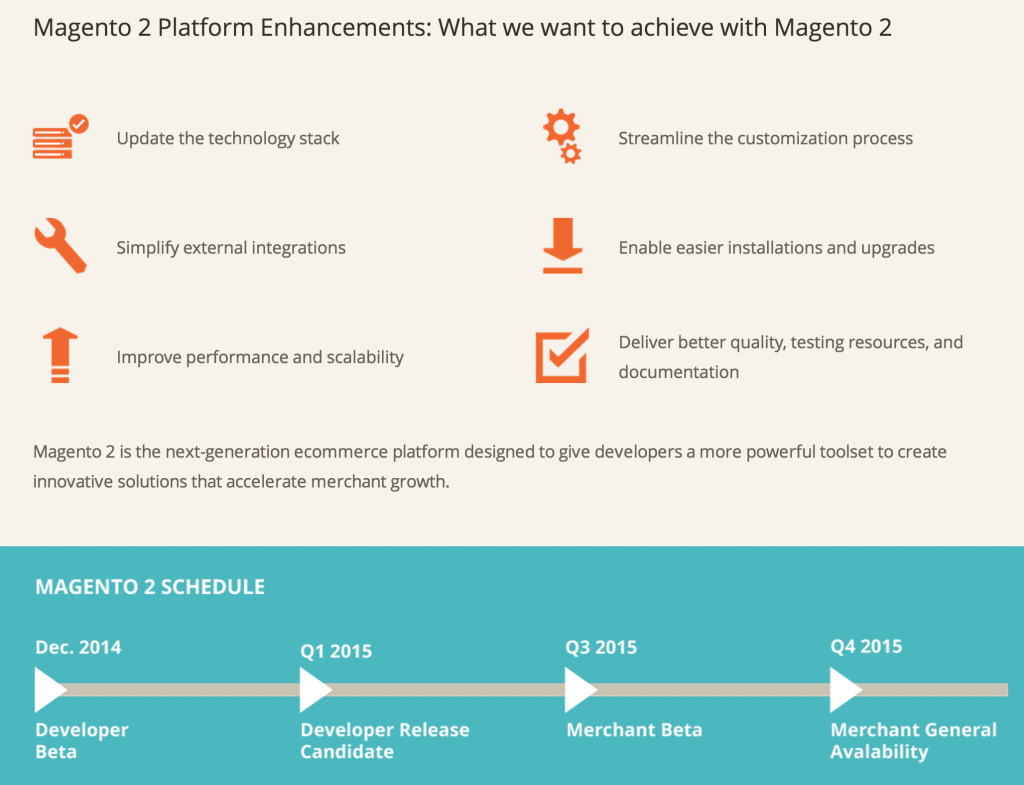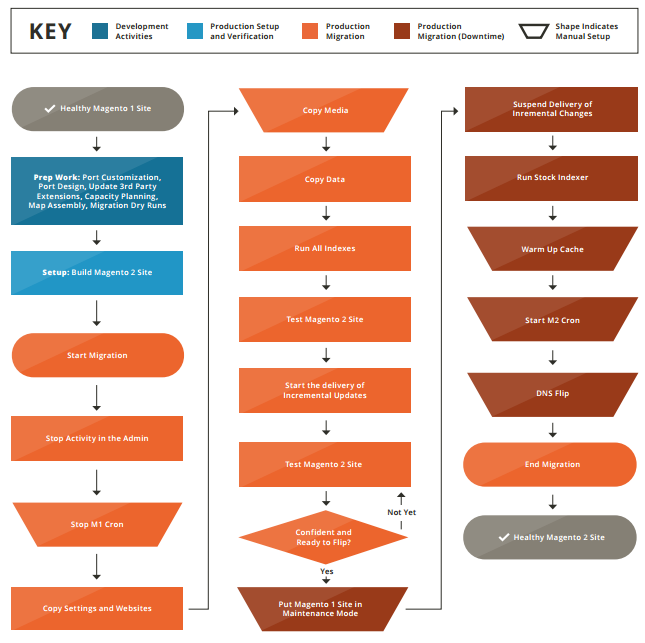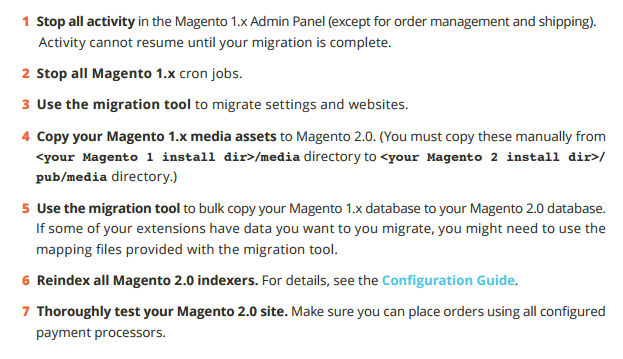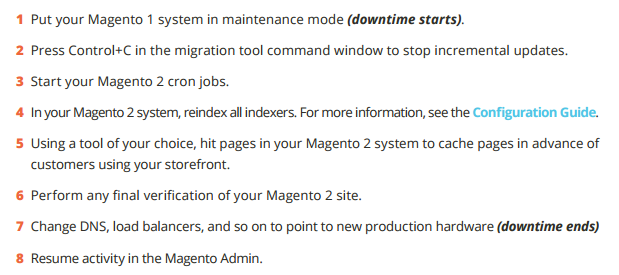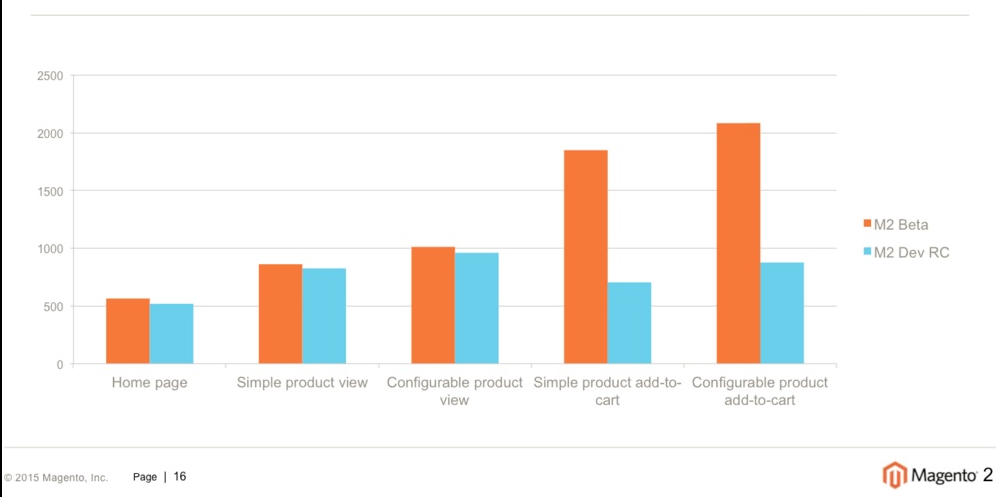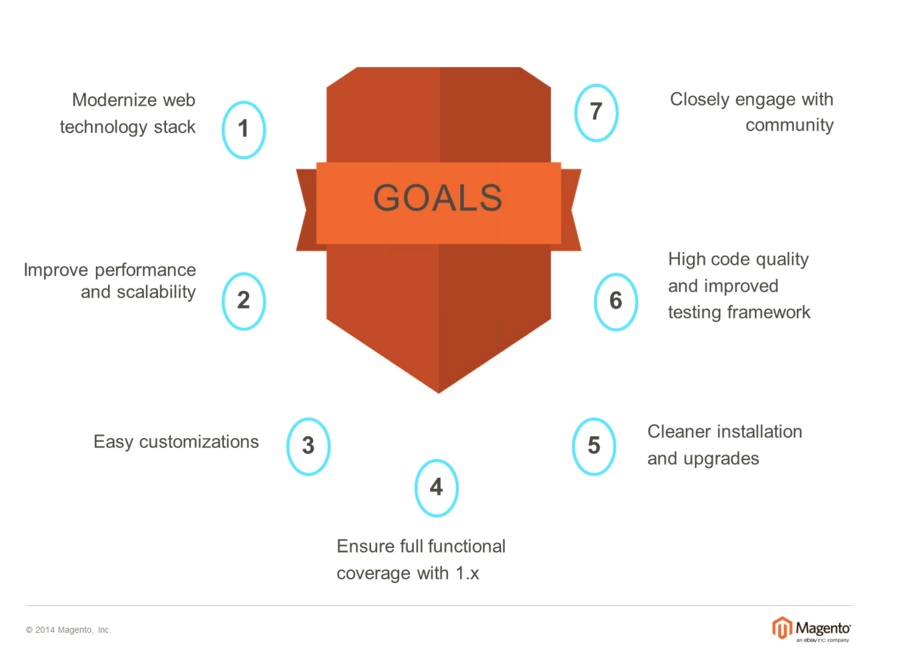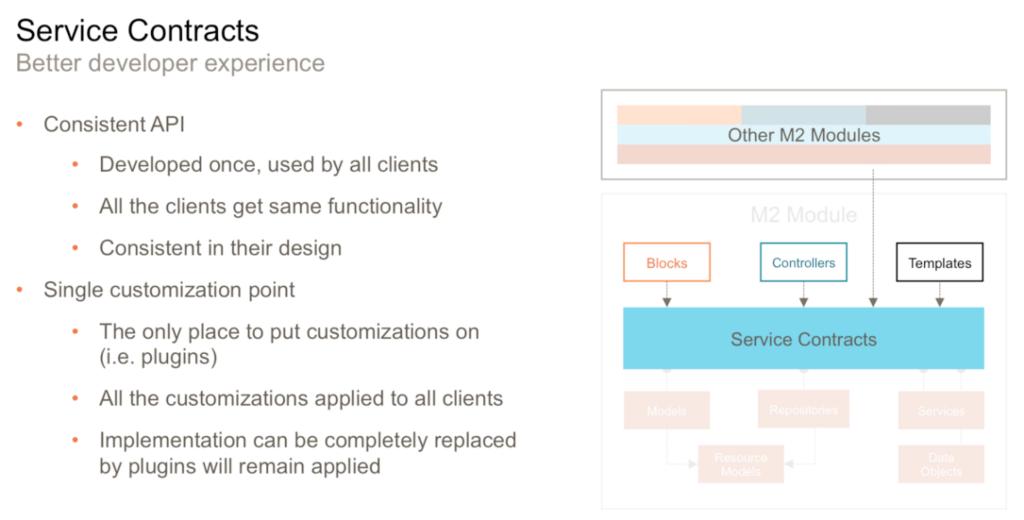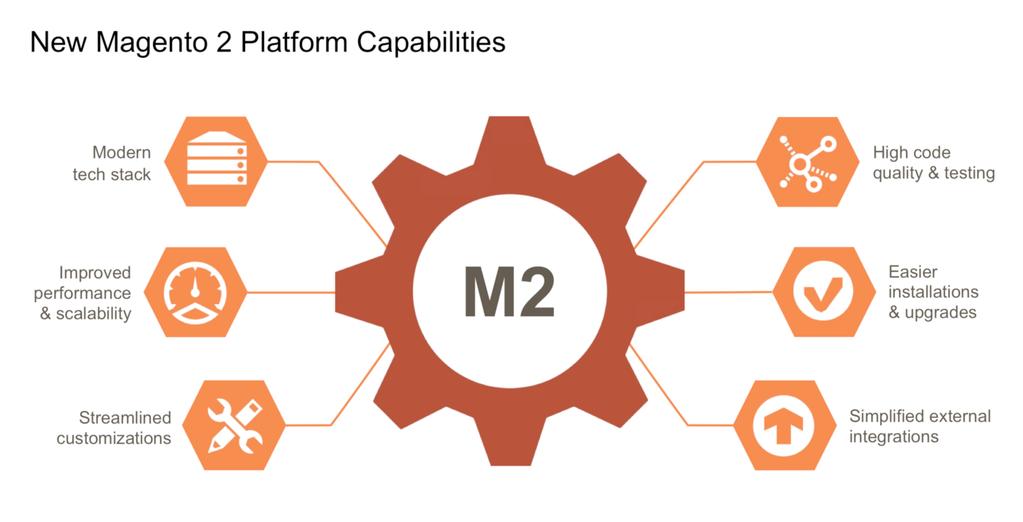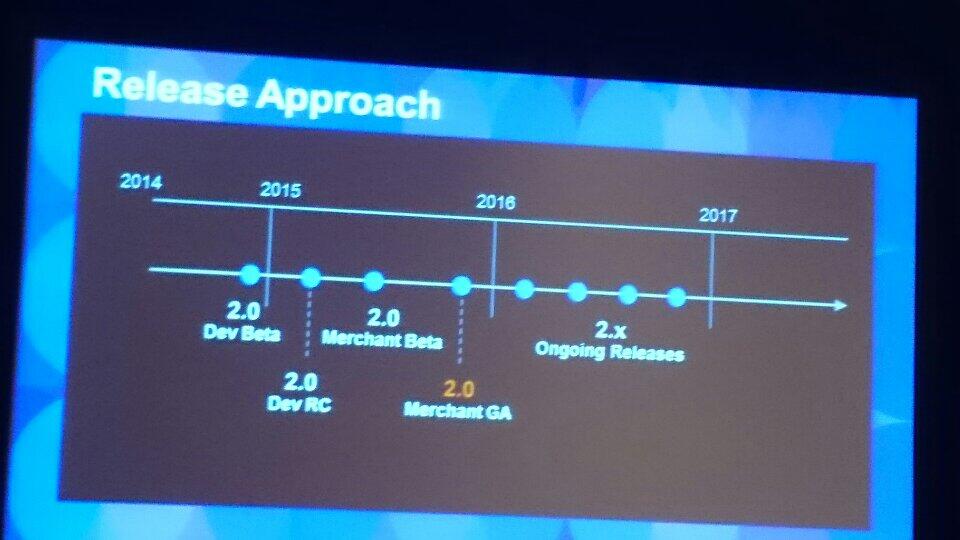Magento 2 Overview – features, reviews, tutorials, demo
The leading online business solution Magento exists for 5 years. It has been downloaded over 4 million times, and now Magento 2.0 is on the way, so get ready for the New Year present. In this article, you can find information about most exciting features of Magento 2.0.
Magento 2.0.1 has been released. For further information, check the release notes here: Magento 2 Release Notes.
| | | | | | | | The Ultimate Magento 1 Developer Resource List | The Ultimate Magento 2 Developer Resource List | | | Magento 2 Release Notes | The Showcase of Magento 2 Shops
Everything about Magento 2 on Firebear
Table of contents
Magento 2 tweets and blog posts
- – all updates and latest news on Twitter
- is Magento Evangelist. He knows everything about the platform. He also has his own .
- is a Magento Chief Architect. Don’t miss his tweets and visit his .
- is a Magento Senior Software Engineer. He will tell you a lot about Magento. You can also check his .
- is a Magento 2 Architect. Enhance your feed with his tweets!
- is a Magento 2 software developer. She also knows what to tell about the new platform.
- is a director of Magento 2 development. Don’t forget to visit his .
- We’ve launched with all Magento 2 pull request and commits, as well as related GitHub projects.
- Guru Alan Storm continues his . It is a must read for ALL MAGENTO DEVELOPERS.
- related to Magento 2 by Cool Ryan
- on Inchoo.
- on MageClass
UPD (August 2014) – In March 2015, we will see the first Magento 2 release candidate. Magento 2 beta release is planned for December 2015. This information appeared after few years of speculation, but now the Magento 2 road map is official and all rumors are dispelled.
UPD (11/09/2014) – Magento 2 Webinar: Performance/Scalability Improvements & Composer Updates
UPD (02/10/2014) – Magento 2 Frontend architecture & Implementing payment gateway
UPD (25/11/2014) – Magento 2 Developer Beta will be available on December 18, 2014.
UPD (8/12/2014) – Magento 2 features & Magento 2 demo full featured front and backend demo links
UPD (11/12/2014) – launched , ver. 0.1.0-alpha107
UPD (18/12/2014) – Magento 2 Developer beta available! Magento 2 release milestones added and explained. launched , Magento 2 Developer Beta Webinar Highlights & Full video
UPD (5/12/2014) – Summary about most important features of Magento 2 for this moment
UPD (10/02/15) – Magento 2 Release Date; 6 Interesting Facts About Magento 2; The Roundup
UPD (23/03/15) – Magento 2 latest news
UPD (24/03/15) – Magento 2 Developer Release Candidate
UPD (25/03/15) – All You Need To Know About Developer Release Candidate
UPD (29/04/15) – Imagine Commerce 2015 and other useful updates
UPD (17/05/15): Fundamentals of Magento 2 development online course is now live
UPD (14/07/15): Migration from Magento 1.x to Magento 2.0
UPD (15/07/15): Magento 2 Merchant Beta has been released!
UPD (17/08/15): Migrating to Magento 2 (a new article on Inchoo) – look in the Migration from Magento 1.x to Magento 2.0 section
UPD (25/08/15): Magento 2 Demo upgraded to Merchant Beta – ver. 1.0.0-beta
UPD (17/09/15): Building against Magento 2
UPD (02/10/15): Magento 2 Webinar – Hosting & Performance
UPD (06/11/15): Magento 2.0.0 Release Candidate is now available
UPD (01/01/16): Magento 2 Roadmap 2016
(login: demo | pass – 1q2w3e4r)

Table of contents
- 0.1 Magento 2 Roadmap 2016
- 0.2 Magento 2.0.0 Release Candidate
- 0.3 Magento 2 Webinar – Hosting & Performance
- 0.4 Building against Magento 2
- 0.5 Magento 2 Merchant Beta has been released!
- 0.6 Migration from Magento 1.x to Magento 2.0
- 0.7 Fundamentals of Magento 2 development online course is now live
- 0.8 Imagine Commerce 2015 in Las Vegas – the greatest show about e-commerce
- 0.9 Imagine Commerce tweets
- 0.10 New Magento Connect
- 0.11 Latest Magento’s Videos
- 0.12 Is it necessary to wait for Magento 2.0?
- 0.13 Magento 2 Performance overview
- 1 All You Need To Know About Developer Release Candidate
- 2 Magento 2 Developer Release Candidate
- 2.1 Magento 2 latest news (23.03.15)
- 2.2 10 most important Magento 2 features
- 2.2.1 1 – Better compatibility with other platforms
- 2.2.2 2 – The new level of flexibility
- 2.2.3 3 – Testing-friendly environment
- 2.2.4 4 – Service Contracts
- 2.2.5 5 – The new file structure
- 2.2.6 6 – Hassle-free upgrades and installation
- 2.2.7 7 – Elimination of components and modules
- 2.2.8 8 – The concept of view
- 2.2.9 9 – Better Security
- 2.2.10 10 – The Magento Community
- 2.3 Magento 2 Developer Beta Webinar Highlights
- 2.4 Magento 2.0 Key Milestones
- 2.5 New Magento 2 Features
- 2.5.1 Compatibility
- 2.5.2 Concept of the View
- 2.5.3 jQuery Library
- 2.5.4 New Architecture
- 2.5.5 New Directories Structure
- 2.5.6 New Performance
- 2.5.7 Better Testing
- 2.5.8 Class Alias
- 2.5.9 RDBMS Tabular Structure
- 2.5.10 ORM
- 2.5.11 Jquery Javascript Framework
- 2.5.12 New Level of Security
- 2.5.13 Magento 2 Development Update (December 2013)
- 2.6 Changes to the admin system
- 2.7 The speech of Dmitriy Soroka
- 2.8 Magento 2 Webinar: Performance/Scalability Improvements & Composer Updates
- 2.9 Magento 2 Release Date
- 2.10 6 interesting facts about Magento 2
- 2.11 The Roundup
- 2.12 References
Magento 2 Roadmap 2016
- Staging and preview of changes without any influence on production.
- Improved search (check appropriate extensions here: Magento 2 Improve Search).
- Improved CMS (we already have an appropriate post: Magento 2 Improve CMS).
- New promotion types.
- Better personalization and segmentation.
Magento 2.0.0 Release Candidate
Magento 2.0.0 Release Candidate is now available! You can get it here:
Magento 2 Webinar – Hosting & Performance
Today, we are going to draw your attention to a new Magento 2 webinar, which describes such vital topics as hosting and performance. It’s worth spending 42 minutes of life, especially if you are passionate about the upcoming version of the platform.
from on .
Building against Magento 2
is a good article about problems related to Magento 2. The author shares personal experience and shows all difficulties related to the new version of the platform. Furthermore, he also talks about the importance of Magento 2. 2.X will be useful in theory, but what about its practical meaning? Check the article to find the answer.
Magento 2 Merchant Beta has been released!
This is the last stage before the general availability of Magento 2! Don’t miss ! JULY 16 9:00 a.m. PDT is the beginning of the first official guide to Magento 2 Merchant Beta.
After tons of tests and thousands hours of work, Merchant Beta is available for the community. It looks and feels almost like the GA product. Moreover, new Magento 2 features, such as streamlined checkout and enhances payment processing, are implemented within Merchant Beta. And if you are an Enterprise Edition user, get ready for the updates to transactional emails and import/export functionality, scalability enhancements to order management, database, checkout, etc.
The current stage incorporates real-world challenges. Magento 2 will be tested on ecommerce stores of all possible sizes, configurations, and complexity. And there are and Support Teams aimed at helping merchants with the implementation of GA-based websites or conducting a site upgrade. Thus, the new platform is going to pass a varied set of use cases before its final release.
Furthermore, merchants and developers has lots of new opportunities, related to Magento 2. Both preparations for the migration and the Fundamentals of Magento 2 Development training courses are described below.
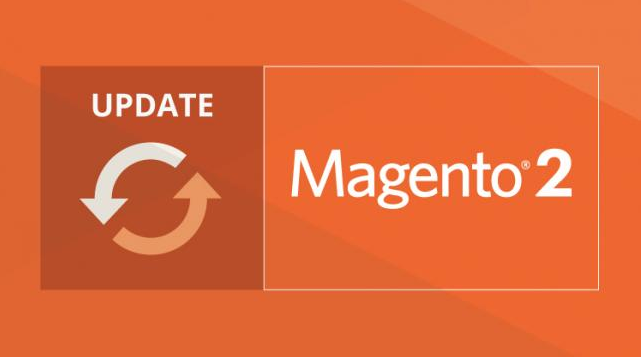
The video below fully describes the current version of the project.
Migration from Magento 1.x to Magento 2.0
We are not only waiting for the final release of Magento 2, but for appropriate migration tools as well. Luckily, there is an , which covers four major aspects: data, extensions, themes, and customizations.
Using the Magento 2 Data Migration Tool, you will be able to port product, customer, and order data, promotions, and different store configurations to Magento 2. Unfortunately, there isn’t any tool for importing extensions, but the Magento development community is working on making them available for the second version of the platform. At the same time, there are tons of new opportunities for themes and customizations.
The level of effort to migrate from 1.x to 2.0 depends on your previous work with a website. It means that simplicity of migration is inversely proportional to a level of customization. And an average Magento 2 migration is about 20% larger than a store upgrade between 1.x versions. But how does the migration tool look like?
The Magento 2 Migration Tool is a data migration command-line interface solution which features progress tracking, auxiliary verification, testing functions, logging, etc. The new software allows direct data copying between Magento 1.x and 2.0 databases. It should be available by Q3 2015.
The migration is based on ETL – extract, transform, and load. The tool should transfer almost everything from your old store to a new one as quickly as possible. The migration of customized data is based on a declarative language. In addition, migration steps are used for making it easier to write a complex code which is necessary in a case of custom needs.
How to simplify migration
-
Using a replicated Magento 1.x database instance will help you a lot.
-
Removing unnecessary data from a Magento 1.x database will also simplify your migration. Keep in mind, that you can remove order quotes, logs, recently viewed or compared products, event-specific categories, etc.
-
Don’t forget to stop administrative activities on both shops.
-
In a case of Magento Enterprise Edition, you could have unarchived orders – archive them.
Migration plan
Prerequisites
Set up the configuration and mapping files as described in the official documentation on Magento 2 migration.
Prepare your Magento 1.x website
Plan your growth
Make your first steps with Magento 2
Perform the migration
… and the incremental migration
Only now you can go live
The following Magento components should be migrated manually:
- Extensions;
- Custom code;
- Media assets;
- CSS and JavaScript;
- Templates and layouts;
- Credentials of web services;
Don’t migrate the data below:
- Google Shopping
- Indexed data
- Not supported in Magento 2.0 data
You can find the description of Database Configuration and Mapping Files .
UPD (17/08/15): Migrating to Magento 2 (a new article on Inchoo)
If you are still looking for more information related to Magento 2 migration, we recommend you to check on Inchoo. Unfortunately, the author of the article says that we won’t see any quick and easy upgrade in the nearest future. But there will be an opportunity to schedule the procedure until 2017, as Magento 1 will be supported until 2018. This time is enough to create a robust solution for a migration from 1 to 2, as well as making the new version of the platform stable.
Now, it is possible to move the core data related to products, orders, customers, store configurations, and promotions. Since there is a totally different structure for themes in Magento 2, they have to be refactored, which is not an easy task. The same is about third party extensions: you will need to get the new ones compatible with the second version of the platform. Note that Magento Connect will be replaced with a real app store, so it won’t be as difficult as it is now. More information on the blog post! The author shares ideas about the influence of a migration process on businesses. Despite some things seems obvious, the article still deserves attention.
Other useful information on Magento 2
If you have any questions related to Magento 2, you can probably find answers on . For instance, there is a screencast with an introduction to Magento 2 for 1.x developers or a post related to code generation in the second version of the platform.
Alan Storm also has tons of useful information on his website. For example, he explains such important topic as .
You can also check the official .
In addition, you can check on Semaphore Software. The author tells about Magento 2 features that make it overpowering. They are:
- Customizable file structure;
- Intuitive layout;
- Top-notch performance and advanced scalability;
- CSS Preprocessing;
- Stable JQuery;
- Unbelieveable user experience.
And don’t forget to check a public .
Fundamentals of Magento 2 development online course is now live
Magento 1 developers now have a perfect chance to learn more about Magento 2 platform. Fundamentals of Magento 2 development online course covers core concepts of Magento 2, including design, architecture, request flow, and rendering. By the end of this course, you will be able to set up new modules and configuration variables; use plugins, interceptors, and observers; create custom controllers; and override controller action.
To become student of this course, you should be familiar with LAMP environment; Unix-based systems; HTML, CSS, XML, PHP 5.0+ and object-oriented programming techniques. Your PHP experience should not be less than 2 years. Understanding of MVC and Zend Framework is also a plus, but not a strict requirement. And, of course, you should have experience in working with Magento 1.
Currently, this course consists of 3 units: Preparation and configuration; Request flow; Rendering. Additional units coming soon: Database; Service contracts; AdminHTML. The length of every unit is 6-8 hours. “Early Bird” price is $289; regular price is $689.
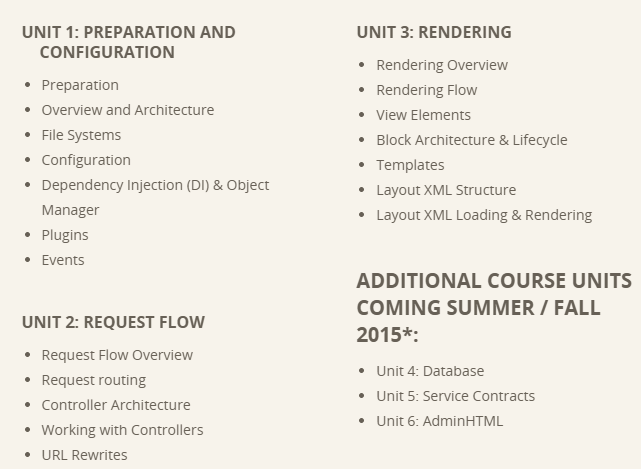
Fundamentals of Magento 2 development
Imagine Commerce 2015 in Las Vegas – the greatest show about e-commerce
The show was all about innovations, revelations, and future plans. Such important topics as Innovation in payment and Customer Driven Innovation were covered during the first day of Imagine Commerce 2015. There also were Merchant to Merchant, Omnichannel Intelligence, Affiliate Exchange and other sessions. General Session. Keynotes, and Breakout Sessions became the major filling of the second day. During the third day of Imagine Commerce 2015, such important events as Designer and Developer BarCamps, Networking, and Magento Partner Summit took place. These are the major news:
-
Sherrie Rhode is now a Community Manager;
-
is now official. Hit the link to check the new affordable platform for the small businesses;
-
Developers now get attributions for their contributions to Magento 2. All community is turning into a family;
-
Magento 2 GA should be released at end of year as it was planned before;
-
A new version of Magento Connect is in progress.
-
New era of open source – the president of eBay says, that it wins every day and every time, and the whole conference was about open source.
Imagine Commerce tweets
Imagine Commerce Partner summit
report Partner summit
— DCKAP (@DCKAP)
International eCommerce online growth
International eCommerce online growth. Info from partner submit thanks
— DCKAP (@DCKAP)
Checkout scaling in Magento 2
Almost linear scaling of checkout in — Anton Kril (@AntonKril)
Magento 2 Merchant Beta on track
Magento 2 Merchant Beta on track — DCKAP (@DCKAP)
Scalability and prformance of Magento 2
scalability and performance: multiple database level
— Ignacio Riesco (@ignacioriesco)
Magento 2 throughput
throughput… 🙂
— Ignacio Riesco (@ignacioriesco)
New Magento Connect
Is it necessary to wait for Magento 2.0?
As mentioned before, Magento 2 should be available by the end of 2015. But is it necessary to wait for the release or 1.9.2 is enough?
First of all lets start with the benefits of 1.9.2. It the latest available stable version of Magento. By using it, you get the omnifarious support on different forums, so you don’t have to be afraid of problems. There are also tons of plugins and extensions. 1.9.2 provides your e-commerce shop wit the responsive design from the very beginning. Furthermore, it works with most modern JavaScript libraries due to incorporated jQuery. 1.x versions will receive official Magento support during the next 3 years after 2.0 will be introduced. Last but not least is the data upgrade path from first to second version of the platform. You will get the ability to transfer information about your products and customers from 1.9.2 to 2.0
There are also several drawbacks in using 1.9.2. There are no any tools for upgrading modules and themes. Magento 1.9.2 is based on outdated technology stack.
At the same time Magento 2.0 provides a lot of benefits. Your customers will get mobile first experience. The platform is based on the latest PHP / MySQL and up-to-date technology stack, as a result you get better performance. There is also a Magento Testing Framework, designed for better modules. And don’t forget about improved installation. Furthermore, Magento 2.0 provides better customization options due to the new UI library and CSS Pre-processors. Last but not least is a better indexing processes, which is a plus for big businesses.
But what are the drawbacks of 2.0? It will be released only in Q4 2015. Most developers don’t know what to do with the new version of the platform. We still don’t know all Magento 2 features. The number of Magento 2 extensions is limited.
Is it necessary to wait for Magento 2? We don’t think so, especially if you are going to create a small or medium e-commerce store. Magento 2.0 will be released in Q4 2015, but it doesn’t mean, that it will be as mature, as 1.9.2. Keep in mind, that there will be a lot of problems and bugs, a limited number of extensions and developers. Magento 2.0 will be able to provide the same opportunities as 1.9.2 only somewhere in 2016.
Magento 2 Performance overview
Nexcess provides a document with details of the Magento 2 performance. To get the White Paper, hit and fill in the form. The research shows differences between Magento 1.x and Magento 2. It provides all the necessary information about performance and scalability, new frontend and backend, LAMP stack, static assets, indexing, cache pools, new app modes, etc.
The overview is based on March release of Magento 2. It starts from Performance and its architecture. Then there is an overview of static view, file caching, app modes. Next is app caching. Deployment configuration is another topic covered in the White Paper. There is also a coverage of indexing performance improvements. Last but not least is the upgraded solution stack. In addition, you will get benchmarking against Magento 1.X.
All You Need To Know About Developer Release Candidate
Magento 2 developer Release Candidate is fully official. This means that its time to start porting and adjusting Magento 1.X extensions to Magento 2. All milestones had been hit as planned, the community did a lot of contributions to Magento 2, but Magento 2 team is still looking for feedback.
Web APIs improvements
Services are now able to set data, instead of only getting it of the resources which they represent. The improvements affect Data Entities from the Api/Data directory. The attempt to implement mutable data entities by using a builder pattern was too complicated to use in practice. Now, service contracts can be exposed as web APIs in a SOAP & REST form with the help of a few XML lines.
Performance
The performance of Magento 2 Dev RC is higher than the performance of Developer Beta, but it is currently far from the final version of the platform. Some requests are almost two times faster, the same is about LESS compilation. There is a performance toolkit for , which is also available for . Last but not least is that Magento 2 has been verified to be compatible with the open-source virtual machine HHVM 3.6.
Improved Codebase
The codebase of Magento 2 has seen some major changes and still remains as a subject to change. For instance, there are module-specific unit tests designed to make modules more standalone. You can now find them . The usage of Composer has been also changed. The backwards compatibility policy will be based on . Get ready for the of public facing APIs from Magento 2 framework in a few months.
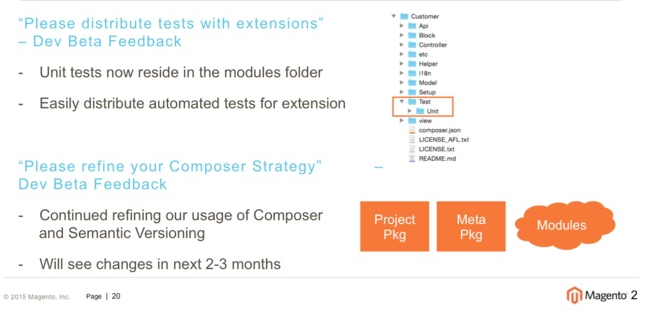
Unit Test Distribution and Composer
Frontend changes
Magento 2 features server and client side compilation of LESS files. The first one relies on GruntJS, NodeJS, and LiveReload. The second compilation now supports i18n for translations of JavaScript-supplied text-constants. There is also completely overhauled interface of the setup tool, which is now build with the help of new UI framework.
Migration from Magento 1.X
Magento 2 offers migration tools which are flexible enough to work with any previous 1.X Magento version. The live synchronization will be possible with the help of MySQL triggers. Taking the store down will not be necessary for the migration from Magento 1.X. Specialists are still working on tooling for porting code. The results should be announced in the nearest future.
Training & Certifications
Fundamentals of Magento 2 Development will be a paid training program, but its price is still unknown. It will include two chapters. The first one focuses on “Preparation and Configuration”, “Request Flow” and “Rendering”. The second chapter covers such topics as “Database” and “AdminHTML”. They will be available in April and somewhere in summer respectively. Magento 2 certification program will come only in 2016.
Other interesting facts
- Payment modules APIs will be refactored.
- The checkout process will be revamp in the nearest future.
- Magento U trainings will be paid, but Magento will also supply free online materials.
- The approval of new extensions in Magento Connect will require code review.
- Magento 2 enterprise and community editions will be released at the same time.
Magento 2 Developer Release Candidate
The Magento 2 Dev Release Candidate (RC) was announced ago at Imagine 2014 along with Developer Beta and Merchant Beta versions of Magento 2. This happened almost a year ago, and now the development milestone is reached. Magento 2 Dev Release Candidate represents three things:
-
A completed platform architecture. It is anticipated, that there will be no major architectural shifts between Dev RC and the general release, which is planned for Q4 of 2015
-
Incorporation of feedbacks. Developer Beta participants from all over the world took part in the creation of this version. There were two separate in-person developer forums which gathered participants from four continents. As a result developers got enough feedbacks to bring Dev RC to its current state.
-
Deadline compliance. Because of coordinated work of many specialists, Developer Beta period was completed on time.

Magento 2 Developer Release Candidate
If you are already involved in different discussions on Twitter, GitHub, or email – go on. You can also play with Magento 2 Dev Release Candidate to provide your creative ideas, feedbacks, missed features, and fixes.
If you are not – it’s time to begin. It is not the production versions, which will be released later this year, but Dev Release Candidate provides a perfect opportunity to install Magento 2 and explore the new architecture. You will be also able to contribute to the codebase. All feedbacks are still very important for the developers.
The developer community has a lot of work. Now they get focus on porting their own code into the Magento 2 idiom and continue to incorporate community feedbacks and contributions. Performance enhancements also takes a lot of priority at this stage.
Magento 2 latest news (23.03.15)
-
invites everyone to develop a tool which shares code between Magento 1 and 2, or programmatically converts code from one version to another. There is also a good opportunity to architect one extension that is useful for both versions of Magento (don’t forget to check the prizes!).
-
The changes of and – include:
-
Such modules as Magento_Config and Magento_Variable now have better separation of concerns.
-
Dependency injection framework has got various improvements. As a result, a combined performance improvement reached 3%.
-
has been improved.
-
has been streamlined.
-
The changes also affected all inline JavaScript code. It has been eliminated.
-

-
The developer documentation of Magento 2 privately. are still required.
-
Magento 2 extension has been realised.
-
More about for Magento 2 by Alan Kent.
-
explanation by Peter Jaap.
-
Magento 2 Developer Release Candidate is now available! A dedicated webinar is expected on Tuesday, March 24, from 9:00 a.m. to 10:30 a.m. (PDT). Frontend and composer changes, performance enhancements, simplified services, data migration tools are now parts of Magento 2 Developer Release Candidate. Magento U preview training classes and development timeline are also among webinar program.
10 most important Magento 2 features
Magento is a leading e-commerce solution, that exists during last 5 years. The platform has more than 4 million downloads worldwide. And now we can witness the dawn of Magento 2. The new version of the platform promises a lot of new features that have all the chances to play a key role in the growth of e-commerce market. In this post you can find 10 most important features of Magento 2.
1 – Better compatibility with other platforms
Magento 2 is compatible with Zend Framework and PHP 5.5.0|~5.6.0|~7.0.0, it also extends support for MSSQL, Oracle, and other databases. Check Magento 2 System Requirements
2 – The new level of flexibility
With a new structure of modules (component-based), the new Magento has a much better flexibility in terms of development. The high code coupling in combination with a component oriented structure allows developers to different components including CMS, customer, checkout, sales, catalog, and a lot more. In Magento 2, it is possible to disable or enable every component and at the same time to keep the code base clean.
3 – Testing-friendly environment
Magento 2 is 100% testing-friendly. It includes a flawless testing framework designed to perform: Static Tests, Performance Tests, Unit Tests, Legacy and Migration Tests, Integration Tests and JavaScript Unit Tests.
4 – Service Contracts
Service Contracts is another important feature of Magento 2, which is based on a set of different PHP Interfaces. The feature improves and simplifies the use of APIs for various modules. With Service Contracts, developers will get a new way of working with public API endpoints.
5 – The new file structure
Magento 2 comes with a completely new file structure. There is no base theme anymore and all the base views are in the module structure. Developers now face much less issues while developing custom Magento themes.
6 – Hassle-free upgrades and installation
Composer makes Magento 2 more friendly for an installation and updates. It is also possible to use a convenient format to upgrade to the latest Magento 2 version.
7 – Elimination of components and modules
Magento 2.0 provides advanced payment options. The new version of config.xml file is reduced by over 20%, as a result developers are able to offer customizable solutions within less amount of time.
8 – The concept of view
The complexity and overall development time in Magento 2 has been considerably reduced thanks to ‘the concept of view in the module’. The feature also enables developers to create the working view within no time.
9 – Better Security
Thanks to the changed directory structure, Magento 2 is more secure. There is a new directory – ‘pub’, which enables developers to protect the code from different security breaches.
10 – The Magento Community
The Magento development team is opened to the community of Magento coders, ерфе can receive a seamless support for any issues with Magento 2.
Magento 2 Developer Beta Webinar Highlights
- The Magento 2 Developer Beta webinar recordings will be posted on the Developer Hub
- The latest magento2 dev version requires version PHP 5.6
- Magento promises working demo of new Connect at next Imagine, in Q2 2015, will also support payments in the future.
- MAGENTO 2 DEVELOPER HUB Latest news, resources, events, and more to help you prepare for the Magento 2 release
- There are no product types in Magento 2. no configurable/simple, instead you generate variations based off attributes
- Magento 2 Sample extension –
Now we know for sure, that Magento 2 is ready for developers but definitely not for merchants. Developers are not recommended to adopt extensions for the new version of the platform, as there might still be breaking changes. It should be postponed until the Magento 2 RC in Q1 2015. For extra details you can visit Magento 2 Developer Hub, which hosts official documentation, posts and video tutorials. Every page of new documentation is available on Github, providing developers with the easiest way to contribute and run their own instances.
Another significant novelty introduced in Mageto 2 is Service Contracts – a set of fundamentally PHP interfaces which will improve and simplify the use of APIs for modules, developed to communicate with other modules. In addition, developers will be able to expose public API endpoints via XML configuration.
Additionally, a new Magento Connect is on its way. It should make vendors life easier and highlight the best extensions through a new verification program. The timeline for the new Connect includes 3 milestones: updates to the Current Connect (Q1 2015), Demo of the New Connect (Q2 2015) and Launch of New Connect and Verification Program (Q4 2015).
There will also be Magento U courses for Magento 2 in March 2015, but there are no official information about new certifications.
Magento 2.0 Key Milestones
Magento relies on development practices which are similar to the Scale Agile Framework. Taking this into account, we can talk about 4 key milestones: Developer Beta (the end of 2014); Developer RC (Q1 2015); Merchant Beta (Q3 2015); and General Availability (Q4 2015). There are also two major areas of work which are likely to continue until the end of 2015 (General Availability): Service Contracts and Performance & Scalability. Both are equally important for the new version of the platform.
Magento 2 Developer Beta – Available Now!
Magento 2 Developer beta available! –
Updated tech stack (newer versions of Apache, PHP, MySQL, etc); modern coding style; new infrastructure for theme inheritance; Composer support; service contracts; upgraded refactoring of CSS, HTML and JS assets are inevitable components of Developer Beta phase.
Magento 2 Developer RC
Developer RC will be stable enough for developers to port their extensions to the new version of platform. If you need a more stable environment, you will have to wait until the end of this phase. The goal of Developer RC is to complete all platform changes.
Magento 2 Merchant Development
This period will be focused on Merchant functionality. EE modules will also get more attention during Merchant Development stage.
Magento 2 Merchant Beta
There will also be a beta phase for Merchant functionality, which is extremely necessary for the final release. The period will include a lot of minor changes with the potential impact on extensions. The key goal of Magento developers will be the minimization of this impact.
Magento 2 Merchant GA
Based on Merchant Beta feedbacks, the final version of new Magento will be released on the end of 2015, but there is a probability that the release will be scheduled until the beginning of 2016.
Magento 2 – the latest news from Github
These are some headlights of 0.1.0-alpha 104, 105 and 106:
-
The local.xml configuration file is now replaced with an associated array in config.php.
-
The functional tests for Bundle, CMS, CatalogSearch, Customer have been stabilized.
-
The quantity of unused objects has been decreased, the product attribute metadata is now cached; and the setup tool is improved.
-
All interfaces have received the “Interface” suffix.
-
SQL and Data Upgrades for Weee, Tax, Customer, ProductAlert, CustomerImportExport, Wishlist and Sendfriend modules are now merged.
-
The UI has also got several improvements: UI library documentation, improved footer alignment, Luma theme instead of Plushe, and more semantic HTML.
-
Additionally, different bugs have been fixed too.
And don’t forget that:
-
The 18th of December is the date for the Developer Beta release.
-
There will be a native support for nginx in Magento 2.
-
The Magento 2 readme is seeing a fast expansion.
Magento 2 key updates
- The new technology stack
- Improved customization process
- Easier frontend development
- Lower upgrade costs and efforts
- Better scalability and performance
- New level of quality, documentation and testing resources
- Increased engagement with the community
1.The new technology stack
The new technology stack includes the latest versions of PHP, JQuery, CSS3, etc.
With JQuery Magento 2 is more accessible, as a result, developers are able to use a JavaScript libraries they already know. The supports for additional plugins is also provided.
- Magento 2 is fully responsive and based on HTML5. Customers get a great shopping experience on every device, and developers are able to use powerful APIs and features from HTML5.
- CSS3 improves page load speed of Magento 2. It also provides a bunch of new visual effects: reflections, multiple backgrounds, shadows, etc.
- Another great feature of Magento 2 is a RequireJS library. It helps load JS resources asynchronously. As a result you get improved page load time and encourage modular design for front end components.
- The second Magento also supports PHP 5.5 (5.4.11 is the minimum requirement). As a result, Magento 2 provides better overall performance.
- There is also a support for MySQL 5.6 in Magento 2. This version of MySQL can essentially improve MySQL engine performance.
- With the addition of PSR compliance, Magento 2 is easier to learn. In addition, it standardizes the use of PHP, as a result, you get the ability to use different sets of code libraries.
2. Improved customization process
With improved customization process, developers are now able to extend Magento to meet specific merchant needs faster and easier.
- The modular code of Magento 2 reduces cross-module dependencies and allows developers to make targeted changes without any impact on other areas of code. This also leads to cleaner interfaces among multiple extensions with higher flexibility and better customization.
- There are a layered navigation and modularized search interface in Magento 2. As a result, search functions are more customizable.
- Magento 2 provides enhanced APIs for better integrations with external systems.
- Another significant addition to the new Magento is XML validation. It checks that XML code follows specific structures and rules.
3. Easier frontend development
Frontend development is also more accessible in Magento 2 with LESS CSS preprocessor and modern HTML5 themes.
- Developers now have more opportunities for an easier customization of the look and feel without changing core site functionality. As a result, they can pay more attention to user experience, formats and styles. Frontend coding in Magento 2 is less complex and more autonomous.
- Magento 2 also provides features that make CSS more extendable and maintainable in a theme-friendly way. CSS-preprocessor speeds up frontend development and improves multilevel theme inheritance – developers can recompile CSS for all dependent themes with the dedicated updated parent themes. Instead of LESS CSS preprocessor, developers can also use Sass/Compass.
- Magento 2 also includes a Blank Theme, which allows developers to start with a stripped down the theme and all the necessary features and customizations.
- The Magento UI Library includes a lot of different components (typography, tables, forms, etc.) and specific patterns (messages, navigation, ratings). It provides the ability to change almost all elements of Magento 2 front end. With UI patterns defined within the library, developers can create new themes or modify existing much faster.
4. Lower upgrade costs and efforts
With lower upgrade costs and efforts, it is easier to upgrade all core Magento software and install extensions in Magento 2.
- Upgrading Magento to a newer versions is now easier, because Magento 2 includes information on versioning policies. In addition, you can get all the necessary information about compatibility of upgrades with the current version.
- Magento 2 includes a standalone installer, which is a separate and independent script.
- Upgrading to Magento 2 is possible by exporting all standard records and importing them into Magento 2.
5. Better scalability and performance
Performance Improvements include improved indexers, the new Magento performance toolkit and integration with Varnish Cache. Scalability improvements include full page caching and support for multiple admin users.
6. New level of quality, documentation and testing resources
Magento 2 includes tests for units, integration, static environments, performance criteria, and functional areas. To enable faster development, the testing framework of Magento 2 supports continuous integration and testing practices. In addition, the new version of Magento includes all the necessary documentation.
7. Increased engagement with the community
Increased engagement with the community is another a strong point of Magento 2. Updates on Github, Magento 2 webinars and special events make the platform more opened to the community.
New Magento 2 Features
Compatibility
As original version, Magento 2.0 runs on PHP 5.3 and Zend Framework. It has support for MSSQL and Oracle, which is a good news for Windows Platform Server. As you can see, Magento keeps growing and Magento 2.0 has support for more popular platforms.
Concept of the View
In Magento 2.0, there is the concept of the view in the module, which is the replacement of the existing base design package. Now you don’t have to define the configuration file, because it is possible to create the view instead. Replacement of base directory and integration of view into the whole system are two major changes in Magento 2.0.
jQuery Library
jQuery library is the default JavaScript library in Magento 2.0. In Magento 1.x the prototype.js was used as a base javascript framework, but it is not so popular among Magento developers as jQuery, so for frontend developers migration from prototype to jQuery is one of the most important changes in Magento 2.0.
New Architecture
Magento 2.0 has Component Oriented Architecture. The modules like customer,catalog, checkout, sales, CMS and others exist as components and interact between each other with high code coupling. So if you don’t need to use a certain module, you can always disable it and replace with your own. You don’t also need to install the whole thing and hack the existing code base to customize and tweak Magento 2.0, so the existing code base is clean and the site performance increases significantly.
New Directories Structure
Magento 2.0 has new directories structure, which is quite similar to the Zend Framework. So things like Layout Templates, JavaScript, Images, CSS are more modular and manageable through a module folder.
New Performance
Performance was always an issue for Magento. It was resource hungry and less efficient than other solutions, but everything changes with the 2.0. The new version of Magento is at least 20% more faster than the latest Magento 1.x. This is very noticeable change in overall performance.
Better Testing
In Magento 2.0, it is much easier to setup automated tests then in the 1.x series.
Class Alias
Class Alias has been removed. In Magento 2.0, you just need to put the Class name in the mage class design pattern method.
RDBMS Tabular Structure
A lot of new sections are converted into typical RDBMS tabular structure in Magento 2.0. Also, there are plans to provide NoSQL adapter, so the removing of EAV is inevitable, but in Magento 2.0 it will get improved performance.
ORM
There is a possibility than Magento 2.0 will get a new ORM.
Jquery Javascript Framework
Magento 2.0 has support only for one Javascript framework – Jquery. So there will be much less Javascript conflicts in 2.0 than in 1.x.
New Level of Security
Magento 2.0 has taken some new steps in handling server validation. It will ensure greater security, so the online store will be much safer.
Magento 2 from back-end point of view:
-
PHP 5.5, Zend Framework 1.x
-
MySQL, Oracle and MSSQL databases support
-
jQuery + plugin orientated framework
-
Improved SOAP, XML-RPC, JSON-RPC, REST and other APIs
-
Unlimited theme inheritance
-
New validator library
Magento 2 Development Update (December 2013)
Changes to the admin system
There is a lot of changes in the admin backend of Magento 2.0, but we will focus on the most interesting.
Visual Design Editor
Visual Design Editor is the place, where you can select and modify the theme you wish. Different types of page layout are also there. Very simple drag and drop interface automates the process done by hand and makes it is much quicker and easier. Visual Design Editor can be found under System -> Design -> Editor.
Product Management
In Magento 2.0, products section has a new dropdown menu, which facilitates the whole process of new products addition.
The edit product page also has some new features, for example, the product thumbnail in the “general” section, which helps to identify products much quicker, than in Magento 1.x. Here is also a category selector there.
Tax Management
“Manage Tax Zones” and “Manage Tax Zones & Rates” are the new features in Magento 2.0. With them you can add tax rules based on customer tax class and the tax class of the product.
New Google APIs
In Magento 2.0, Google API section is situated in General section. It has support for such services as Google Checkout, Google Shopping and Google Website Optimizer (Content Experiments).
Automatic Coupon Generation
Automatic coupon generation is now possible in “Auto Generated Specific Coupon Codes” and this is absolutely new feature for Magento.
These are the new Magento 2.0 features.
The speech of Dmitriy Soroka
According to Dmitry Soroka Magento 2 will be the first Magento based on version convention, he also says that there are plans to break backwards compatibility in order to improve the product itself and make system refactoring. Magento 2.0 will not be rewritten from scratch but get a lot of new improvements and new functionality. It will still work on PHP, but with new requirements. The version of PHP will be not less than 5.3. Magento 2.0 will also get better support for MySQL, Oracle, and MSSQL. On JavaScript site, it will get JQuery JavaScript framework. Magento 2.0 will get all best features of Magento 1.0 renewed and improved. Unnecessary functionalities will be removed from the platform. The release is planned for 4th quarter of 2012.
Magento 2.0 will be more opened. All development and collaboration tools will be shared with community. Besides this, Magento team is going to provide a roadmap for the Magento 2.0 and upgrade public code repository more often.
There are different automated tests designed for stabilizing upgrades, processes, and installations for the system. On the product security side, it is going to get improved and more straightforward validation, Dmitriy Soroka also said about introducing “development process automated validation for all top 10 vulnerabilities automation and OWASP lists”.
Magento 1.x is modular, but this feature is going to be improved. Truly Modular Product is addressed to follow loose coupling principles and ability to enable and disable different modules from the backup interface. The admin part will be more customized.
From WEB API perspective, there will be the extend functionality in Magento 2.0. It will also get support for REST and JSON-RPC; and PostgreSQL adapter.
The code of Magento 2.0 will be more developer friendly. The system will get Improved Multiple Languages support and support for multiple languages data entry (now it is possible by creating different stores for differenе languages).
Graphic User Interface design editor will be added to Magento 2.0. It will allow users to manage different page types, specify layouts, work with page blocks, and customize blocks look and feel. 2.0 will also get templates editor, so it will be possible to work with page as with a single html file. The new Magento will put all blocks depending on their positions into proper places.
Safe upgrade between versions is also planned in Magento 2.0 as dedicated application that will allow store owner to make preview of the upcoming upgrade before applying it without any changes to code of existing store.
The module structure of Magento will be Simplified. All module files will be stored in one place. 2.0 will have less conflicts between modules related with database schema modification on extensions level.
Another very exciting improvement is the new Magento structure. It will be based on separate components or groups of modules that have high coupling between each other.
Magento 2.0 will get rid of fallback limitation, so developers will be able to create different theme hierarchy for different seasons and events. Caching techniques, translation mechanisms, HTML semantic will be improved in Magento 2.0.
File structure of Magento was also modified, so the process of Magento installation will be more simple.
Changes also affected Autoload process: Magento_Compiler was removed from the system.
UPD (06.08.14): Magento 2 road map
Magento 2 Webinar: Performance/Scalability Improvements & Composer Updates
Magento 2 Performance and Scalability Improvements
- Integration and improvement of Enterprise Edition indexers
- Performance optimizations using the Magento Performance Toolkit
- Improvements to site caching strategies
- Changes to increase the number of concurrent admin users
- Composer Updates
Overview of Composer and semantic versioning
- Types of Composer packages in Magento 2
- Installing Magento Community Edition via Composer
- Magento development with Composer
- How Composer will work with Connect
Magento 2 And Its Core Changes
Implementing payment gateway
There are a lot of nuances of implementing payment gateway in Magento 2. Specialists from inchoo did a great job explaining all the changes. They used payment gateway API integration to illustrate the updates. Hit the below link for the detailed explanation.
Frontend architecture
The frontend in Magento 2 is now updated with such technologies as CSS3, HTML5, and jQuery. The overall layout manipulations and the file structure also got their improvements. In its turn, Magento UI library now relies on a LESS preprocessor with a built in compiler. All the main differences are perfectly covered in the inchoo blog.
Magento 2 Release Date
We are still waiting for the Release candidate of Magento 2 in March 2015. It seems that everything goes as planned, so get ready for the new update in the next month.
6 interesting facts about Magento 2
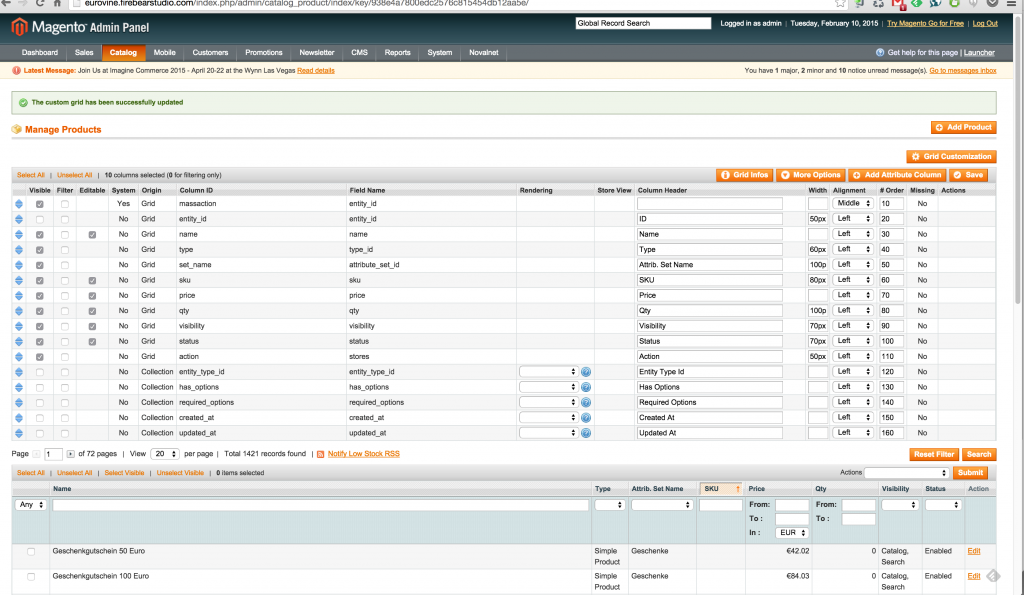
Magento 2
Thanks to “ask-us-anything“ chat we know several interesting facts about the new Magento:
1. Zend 1 is still a part of Magento 2. However, Magento 2 doesn’t completely rely on Zend 1, but it would take too much effort to change it with Zend 2, so the previous version of Zend is still in use. At the same time, Magento 2 relies on different components of Symfony and Zend 2.
2. Database migration tools will be shipped with Magento 2. They will significantly simplify the transition of media and such database entries as customer, product, and configuration data from 1.X to 2. Unfortunately, automatic conversion of themes and modules will be impossible due to some core changes of the platform, but customers will get all the necessary documentation designed to make the process as easy as possible.
3. The repository of Magento 2 CE (magento2-community-edition) is designed for specific Composer builds only. The magento2 repository is designed for complete installations and immediate builds, at the same time the magento2-community-edition repository will contain a boilerplate for hand-crafted Composer installations.
4. New examples of Magento 2 code will appear around the end of March 2015. One of them will show how to add a custom payment provider to the new version of the platform.
5. Get ready for the absence of NoSQL integration out of the box. But don’t be afraid, because it will be drastically easier to implement NoSQL database layers in Magento 2.
6. No new countries will host a Magento Live event in 2015. You can find the complete overview of all Magento-related events .
The Roundup
-
Something terrible happened in the middle of January: Magento store APIs were inaccessible because of servers hosting XML schemas required for SOAP requests were down.
-
It seems that the New York Times Store is running on Magento.
-
To solve the problem of locking SELECTs on the eav_entity_store store table, you should add a not available by default additional index. It might help.
-
Thanks to Aoe_LazyCatalogImages, Magento lazyrenders catalog images instead of generating them during every page load.
-
n98-magerun 1.94.0 introduces a lot of fixes, improvements, and some additional features.
-
The Magento Testing Framework develop branch is now at 1.0.0-rc.15.
-
Magento 2 stable version is :
-
Version information for themes is hosted by the composer.json file. As a result, themes see more dependency of Composer. Previously, this information was hosted by theme.xml.
-
PHP 5.4 is no longer supported by Magento 2. 5.6 is required.
-
Uploaded images are compressed.
-
The Magento_Core module is now outphased.
-
Varnish 4 received a support.
-
Jasmine and PhantomJS are used for JavaScript testing in Magento 2.
-
The performance toolkit received improvements.
-
The same is about the setup tool. It provides the ability to disable and enable modules programmatically.
-
-
The community works on “up for grabs” issues.
-
According to the benchmark by Marko Martinovic, Magento 2 beta 3 is much slower than Magento Enterprise Edition 1.14.1.0.
-
Cyrill Schumacher released an extension designed to make the Twig template engine suitable for Magento 2. There is also the dedicated extension for Markdown template engine.
- is under development.

